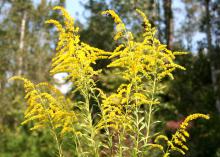Information Possibly Outdated
The information presented on this page was originally released on August 30, 2013. It may not be outdated, but please search our site for more current information. If you plan to quote or reference this information in a publication, please check with the Extension specialist or author before proceeding.
Goldenrod can be garden asset, not allergy problem
I am a firm believer that many of our flowering landscape plants are only one or two steps out of the ditch. The goldenrod is no exception.
I sometimes find it hard to believe that some gardeners actually grow it in their gardens on purpose.
Most folks can recognize goldenrods growing wild. In a couple of weeks, we will start seeing their annual explosion of golden color. Flowering goldenrods are a sign that cooler fall weather is not far away.
Typically, we see European goldenrods, which are tall plants that reach up to 4 feet tall, alongside roads and in ditches. A European goldenrod forms branches from the upper portion of its main stem. Flowers develop on these branches and flow and arch outward.
But there has been a lot of evaluation and selection for more tame landscape varieties. Midsized varieties like the prairie goldenrod can be used in the middle of the shrub border, while smaller selections may be suitable for the front row. Peter Pan and Golden Baby goldenrods have dwarf growth habits.
The selection with perhaps the most outstanding flowering habit is Fireworks. This variety naturally branches close to the ground and has arching branches that radiate flower clusters in all directions. In full bloom, they resemble yellow sparks streaming outward from exploding fireworks. Fireworks goldenrods grow 3 to 4 feet tall and wide.
Goldenrod varieties tend to be unbranched and can look a bit top heavy, especially when flowering. This common sight is readily noticeable along highways. You can train the plants to be denser and bushier by pruning them halfway back in the late spring. Pruning later in the summer can inhibit flower development.
Goldenrods attract many insects, both pollinators and predators, with their abundant floral display in the fall when other plants are starting to fade.
Goldenrods make beautiful cut flowers for the vase, and specimens retain their golden yellow color when used in dried arrangements.
Watch out for one plant disease. Goldenrods are susceptible to rust, a fungal disease that attacks the stem and leaves. Good air circulation can prevent rust from setting in.
Divide flower clumps to easily multiply your goldenrods. Autumn is a good time to divide the plants. Transplanted clumps will readily establish in the generally cool and wet fall season.
Goldenrods grow best in the full sun or on the edge of woodland settings. Don’t worry about epidemic growth in your garden; simply pull up and remove stray plants.
For years, the goldenrod has had a bad reputation during the fall allergy season, but science has come to the rescue of this plant’s good name. Goldenrod pollen is big – much too big to blow around in the wind. In fact, goldenrod pollen grains are so big that insects are needed to transfer them from flower to flower.
Ragweed is the real culprit for fall allergy problems. Ragweed pollen is tiny and easily blown around by the wind. Each ragweed flower produces about a bazillion pollen grains. Both plants flower at the same time, but because goldenrods are so much more flamboyant with their showy, feathery golden flowers, they traditionally have gotten all the blame.
But be bold and try some in your garden this fall.








